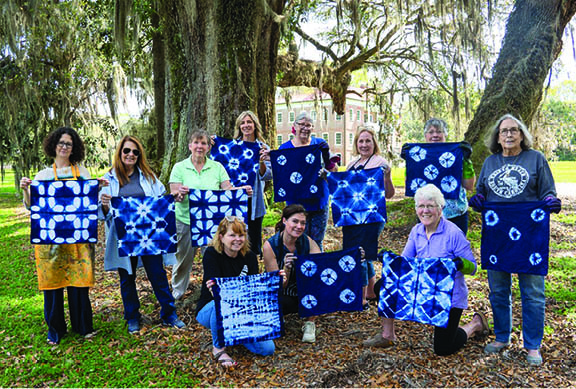Exploring the mystical art of indigo dyeing at Drayton Hall
by Joan Perry | Contributing Writer
 I love blue and I’m not alone.
I love blue and I’m not alone.
I wear blue, eat off blue plates, drive a blue car, and have lived in blue homes. The only thing better than blue is the deep, peacocky, violet darkness of indigo.
It wasn’t long ago that the mysterious color was so precious only royalty and the wealthy could afford it. Color was wealth. It was labor intensive to grow, temperate climates required, processing was complicated, and it was traded worldwide, earning indigo a financial status similar to tea, coffee, spices, and silk.
I had a skip in my step when local Indigo expert Caroline Harper welcomed me to join a Saturday morning of indigo dyeing at Drayton Hall. Along with ten other women, I put on long blue stained rubber gloves and learned the history and process as it was done in the 1700s here in South Carolina.
Women quickly bonded over simmering, foaming cauldrons of dye, as we listened to Caroline’s delightful French accented instructions. Participants were both local and visitors. Beth Trevino is a quilter from Summerville interested in fabrics. Suzie Ball is a member of an Atlanta book club called “Wine, Women & Words.” She joined the session to be a step ahead of the book they were reading. Almost everyone present that spring morning had read the book “The Indigo Girl” by Natasha Boyd. We gave a quick summary to the lady who had not.
In 1739, Eliza Lucas was sixteen years old when her father’s military duty left her in charge of the family’s three plantations in rural South Carolina. They were in financial difficulties and in danger of losing everything, Eliza and Eliza alone, determined that indigo dye was the key to their salvation.
Based on historical documents, including Eliza’s letters, the book is a historical fiction account of how a teenage girl and enslaved plantation workers who shared their knowledge, successfully produced indigo dye, which became one of the largest exports out of South Carolina. The accomplishments of Eliza Lucas and others influenced the course of US history. When she passed away in 1793, President George Washington served as a pallbearer at her funeral.
Much of the story takes place in West Ashley. Partly because of Eliza Lucas Pinckney’s determination, indigo became the colony’s second most important cash crop (after rice), and before the Revolutionary War Indigo accounted for more than one third of the value of exports. That is a big deal. I made a point to walk down Betsy Road to find the plaque noting the location of Wappoo Plantation and her indigo fields.
Originally from France, Harper studied graphic design at the University of South Carolina. After a difficult period, including the death of her mother in 2014, Caroline took some healing meditative time, going to Japan to study the art of traditional dyeing, and found herself falling in love with the world of textiles and natural dyes. The experience changed her life’s direction, leading her and her husband David to become business owners, growing indigo, extracting pigment, and dyeing natural materials to create CHI Design Indigo, a line of home and fashion accessories.
She moved to Charleston specifically to grow indigo and like Eliza, was determined to grow indigo locally again. She didn’t find much here. A friend shared seeds of the true species and through trial and error her dye got bluer and bluer. The indigo now grown in South Carolina is Indigofera Suffruticosa, from Central and South America. The plant grows like a ragged weed 3 – 5 feet tall and reseeds itself. She describes her fields on Edisto Island as an indigo jungle.
The process of growing and extracting the pigment is labor intensive, hot in the summer and smelly as it ferments. Large scale processing would never have been successful without the forced work of enslaved labor. That is made clear by the fact that using the same process, Caroline grows 1,000 plants to produce a precious 30 pounds of pigment, while history tells us that South Carolina was shipping one million pounds to England in 1775.
Caroline led our group through different designs of folding and tying our cloth. We were each making four dinner napkins. With long rubber gloves and smudges on our faces, we tied, wrapped, dipped, timed and dipped again before opening to reveal the design we’d created to spread to dry on the lawn under the oak trees at Drayton Hall.
Caroline has an exciting year ahead. Besides leading Indigo Workshops, Edisto Island Indigo Retreats, Indigo Retreats in the South of France, Private lessons, partnering with Indigo Inn on decor, and the sale of related merchandise, she has written a booklet titled My Journey with Indigo which will be published in April and is working on retail and workshop space. Stay tuned and visit https://chidesignindigo.com/ for more information.
Stay healthy my friends and wave at me as I wander. Send ideas for upcoming columns to westashleywanderer@gmail.com.














